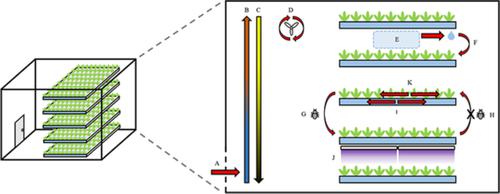当前位置:
X-MOL 学术
›
Ann. Appl. Biol.
›
论文详情
Our official English website, www.x-mol.net, welcomes your feedback! (Note: you will need to create a separate account there.)
Vertical farming systems bring new considerations for pest and disease Management
Annals of Applied Biology ( IF 2.6 ) Pub Date : 2020-03-05 , DOI: 10.1111/aab.12587 Joe M. Roberts 1, 2 , Toby J. A. Bruce 2 , James M. Monaghan 3 , Tom W. Pope 1 , Simon R. Leather 1 , Andrew M. Beacham 3
Annals of Applied Biology ( IF 2.6 ) Pub Date : 2020-03-05 , DOI: 10.1111/aab.12587 Joe M. Roberts 1, 2 , Toby J. A. Bruce 2 , James M. Monaghan 3 , Tom W. Pope 1 , Simon R. Leather 1 , Andrew M. Beacham 3
Affiliation

|
Vertical farming is an emerging area of food production that aims to provide sustainable intensification of agriculture by maximising the obtainable yield per unit area of land. This approach commonly utilises stacked horizontal levels of crop growth in glasshouse or controlled environment (CE) facilities. Vertical farming has, however, received relatively little scientific investigation to date. Consequently, important factors such as economic feasibility, system design and optimisation of production methods are still being evaluated. Vertical farming methods bring additional considerations for the effective management of pests and diseases compared with conventional protected horticulture, such as movement of both pest and beneficial insects between growth levels. This article aims to provide a perspective on the positive and negative issues facing pest and disease control in Vertical farming systems. We highlight important considerations for system optimisation and areas for future investigation.
中文翻译:

垂直农业系统为病虫害管理带来新的考虑
垂直农业是一个新兴的粮食生产领域,旨在通过最大限度地提高单位土地面积的可获得产量来实现农业的可持续集约化。这种方法通常利用温室或受控环境 (CE) 设施中作物生长的堆叠水平水平。然而,迄今为止,垂直农业的科学调查相对较少。因此,经济可行性、系统设计和生产方法优化等重要因素仍在评估中。与传统的受保护园艺相比,垂直耕作方法为病虫害的有效管理带来了额外的考虑,例如害虫和益虫在生长水平之间的移动。本文旨在为垂直农业系统中病虫害控制面临的积极和消极问题提供一个视角。我们强调了系统优化的重要考虑因素和未来调查的领域。
更新日期:2020-03-05
中文翻译:

垂直农业系统为病虫害管理带来新的考虑
垂直农业是一个新兴的粮食生产领域,旨在通过最大限度地提高单位土地面积的可获得产量来实现农业的可持续集约化。这种方法通常利用温室或受控环境 (CE) 设施中作物生长的堆叠水平水平。然而,迄今为止,垂直农业的科学调查相对较少。因此,经济可行性、系统设计和生产方法优化等重要因素仍在评估中。与传统的受保护园艺相比,垂直耕作方法为病虫害的有效管理带来了额外的考虑,例如害虫和益虫在生长水平之间的移动。本文旨在为垂直农业系统中病虫害控制面临的积极和消极问题提供一个视角。我们强调了系统优化的重要考虑因素和未来调查的领域。


























 京公网安备 11010802027423号
京公网安备 11010802027423号